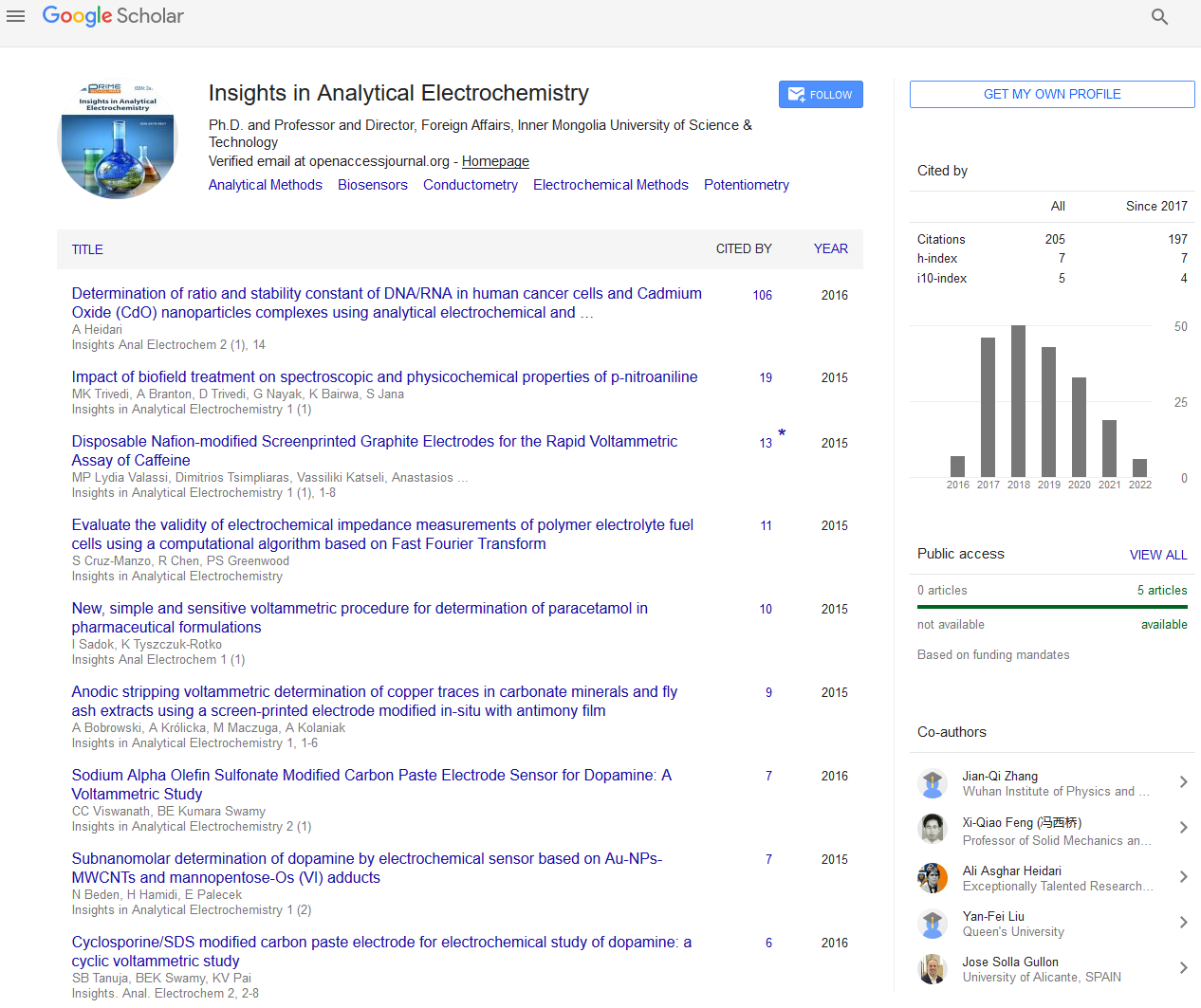Perspective - (2023) Volume 9, Issue 4
Conductometry: Unraveling Solutions through Electrical Conductance
Julie Lawson*
Department of Chemical Engineering, University of Reading, UK
*Correspondence:
Julie Lawson,
Department of Chemical Engineering, University of Reading,
UK,
Email:
Received: 29-Nov-2023, Manuscript No. ipaei-24-18892;
Editor assigned: 01-Dec-2023, Pre QC No. ipaei-24-18892 (PQ);
Reviewed: 15-Dec-2023, QC No. ipaei-24-18892;
Revised: 20-Dec-2023, Manuscript No. ipaei-24-18892 (R);
Published:
27-Dec-2023, DOI: 10.21767/2470-9867-9.4.34
Introduction
In the intricate realm of analytical chemistry, precise methods
of determining the properties of solutions are invaluable.
Conductometry, a technique grounded in the fundamental
principles of electrochemistry, provides a unique avenue for
researchers and analysts to explore the conductivity of solutions.
This versatile method has found application across various
scientific disciplines, offering insights into chemical reactions,
concentration measurements, and the behavior of electrolytes
in solution. At its core, conductometry measures the electrical
conductance of a solution, a property largely influenced by
the presence of ions in the solution. When an electric field is
applied to a solution, ions move, carrying an electric current.
The ease with which these ions move determines the solution’s
conductance, and conductometry quantifies this conductance.
The method is particularly effective in studying electrolytes,
where ions play a crucial role in the electrical conductivity of
the solution.
Description
Conductometry is widely employed in chemical analysis,
providing a rapid and cost-effective means of assessing the
concentration of ions in a solution. Titration curves, generated
by monitoring changes in conductance during a titration
process, offer valuable information about the stoichiometry
and equilibrium constants of chemical reactions. This makes
conductometry an indispensable tool for researchers engaged
in the study of acid-base reactions, complexometric titrations,
and precipitation reactions. One notable advantage of
conductometry is its ability to detect the endpoint of a titration
precisely. Unlike some other methods that rely on indicators,
conductometry directly measures the changes in conductance,
providing a real-time indication of the completion of a reaction.
This attribute enhances the accuracy and reliability of the
analytical results obtained through conductometric titrations.
Beyond the laboratory, conductometry finds application in
environmental monitoring and industrial processes. The
method is used to assess the quality of water by measuring the
conductivity of aqueous solutions, aiding in the identification
of dissolved ions and pollutants. In industrial settings,
conductometry is employed for quality control purposes,
ensuring the proper concentration of components in solutions
used in various processes.
Conductometry also plays a crucial role in the pharmaceutical
industry, where the accurate determination of the
concentration of ions in drug formulations is essential for
maintaining product quality. The method is particularly useful
in formulations involving ionic substances, where traditional
analytical techniques may fall short. Despite its widespread use,
conductometry is not without challenges. The method is highly
sensitive to temperature changes, and variations in ionic strength
can affect the accuracy of results. Modern advancements,
however, have sought to address these challenges. The
integration of temperature compensation techniques and the
use of advanced instrumentation have significantly enhanced
the precision and reliability of conductometric measurements.
In addition, researchers have explored the potential of coupling
conductometry with other analytical techniques, such as
spectroscopy and chromatography, to create multidimensional
analytical platforms.
Conclusion
Conductometry stands as a stalwart in the realm of analytical
chemistry, providing a reliable and versatile method for
exploring the conductance of solutions. Its applications span
from the laboratory to industrial processes, offering valuable
insights into chemical reactions and solution properties. As
technology continues to advance, conductometry is likely
to witness further refinement and integration, solidifying its
place as a cornerstone technique in the pursuit of accurate
and insightful chemical analyses. In an era where precision is
paramount, conductometry remains a beacon, illuminating the
pathways to a deeper understanding of solution behavior and
composition.
Citation: Lawson J (2023) Conductometry: Unraveling Solutions through Electrical Conductance. Insights Anal Electrochem. 9:34.
Copyright: © 2023 Lawson J. This is an open-access article distributed under the terms of the Creative Commons Attribution License, which permits unrestricted use, distribution, and reproduction in any medium, provided the original author and source are credited.

